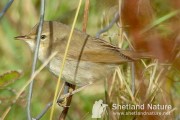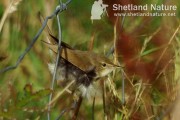Blyth’s Reed Warbler
Posted by Brydon Thomason on Wednesday 6th October 2010 | Birding in Shetland
Our week long ‘Birdwatch’ magazine reader holiday couldn’t have been going better. Our first two days had seen us stacking up a fantastic cast of rarities such as Buff-bellied Pipit, Hornemann’s Arctic Redpoll and Buff-breasted Sandpiper to name but a few. Self finds for the group had already added a fruitful flavour and sense of team spirit in the form of two Little Buntings, Yellow-browed Warbler, Common Rosefinch and Richards Pipit.
The self- finding focus was set to continue when on the morning of the 3rd of October a superb sub-adult White-billed Diver was a brilliant discovery for the group from the Fetlar ferry. It was the finding of a particularly un-obliging acrocephalus warbler, later in the day, that would eventually prove to be ‘bird of the day’ (even if it was only confirmed three days later!).
Autumn ‘acro’s‘ can, and very often are notoriously difficult, especially when un-obliging. With just over half an hour before we had to leave for our ferry off we found an ‘acro’ that even from the first flight views looked very interesting. Time was however not the only factor acting against us, a rather strong southerly wind was freshening making an already elusive ‘acro’ even more determined to find cover.
Right from our first flight views it was obvious that this birds more dainty and compact structure, vary pale, olive and sandy tones and rather ‘fragile’ looking flight was very different to that of the Reed Warblers we had been seeing. To me these features were excitingly familiar and were very strong indicators for Blyth’s Reed Warbler and my co leader Martin Garner also shared my enthusiasm.
With experience these features can be surprisingly distinctive on Blyth’s Reed, as birders familiar with the species will know. Taking identification further is however often a much trickier matter as we found with this bird. Good and prolonged views or indeed photographs are a must to nail the ID. With barely fifteen minutes left before we had to leave, we had managed neither.
Only once distantly and for a fleeting second did we see the bird out in the open when it did seem to show strikingly clean white under parts and distinctly plain and pallid looking sandy and olive toned upper parts and a nice clean ‘super’- all pro BRW features. However without views good enough to accurately assess primary length or tertial detail, both crucial ‘acro’ ID features- we simply couldn’t do anything more with it, we hadn’t even confidently ruled out Marsh Warbler- all seemed lost for our ‘acro’…
A second chance
Three days later a number of visiting birders were on Fetlar for the Sykes’s, and some independently called or texted to report an acro at Aith (exactly the same place). They all favoured identification of the bird as Marsh Warbler. Our bird was still there- we had a second chance!
Accompanied by James McCallum I arrived back at the site. Once again the first flight views brought me right back to my very first impressions; “surely this has to be a Blyth’s Reed?” I asked myself. Glancing over the yard at James who I could see was thinking the very same, we moved in. Moments later the bird worked its way out of cover and out into the open, for the first time revealing itself and indeed the features we so wanted to study days before;
The overall plumage features we had first observed were confirmed- strikingly clean and silky white under parts contrasting slightly with the sandy-olive toned upper parts
The tertials looked plain showing very limited contrast (none at all from some angles and probably more visible on the photographs) and appearing rather con- colourous with rest of upper parts, primaries also lacked contrast with rest of wing (these features eliminate Marsh and Reed).
Primary projection looked relatively short – c70% of the tertial length
Also the super was clean and crisp and quite striking – and extended just marginally behind the eye. Unlike most Reed Warbler it was more obvious than the pale eye-ring
We both agreed-it was indeed a Blyth’s Reed Warbler! Our next view was a prolonged one a fence (oh for it to have done that the first day!), here we had a much better chance to be certain of the features we had discussed. Also now in better light the somewhat characteristic warm ‘bronzy’ wing panel (shown by most Blyth’s Reeds, at least when in good light) created by fresh fringing on the flight feathers, could be seen for the first time.
The above features and indeed for some the flight views are often the main ‘first impression features’ that should set you on the right track for a Blyth’s Reed Warbler identification. In addition and often much harder to see though is the wing structure and formula. Getting these ‘on- screen’ makes life a whole lot easier.
Not only were we lucky to have had a second chance at the bird but also glad that some of the visitors had not beaten us to the correct ID. It was a great and indeed gratifying end result. The following day we were back on Fetlar for MG and the group to actually study and enjoy the bird (when the above images were taken).



